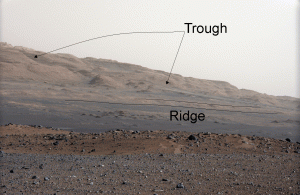A low ridge running along the foot of Mt. Sharp will likely become a prime target for Curiosity, the Mars Science Laboratory rover as it approaches the mound. The reason, outlined in a recent paper in Geology by Abigail Fraeman (Washington University, St. Louis) and a team of coauthors, is that the ridge appears capped with a substantial deposit of hematite. This iron mineral forms in association with water, and thus could help scientists expand the story of water and ancient habitability in Gale Crater.

HEMATITE RIDGE. At the foot of the giant mound in Gale Crater lies a ridge about 5 to 10 meters (16 to 33 feet) high that appears capped with hematite. This iron mineral could have much to say about the habitability of long-past envronments in Gale. Look for it to be a target for the Curiosity rover. (Image combines Figs. 1-3 in the paper.)
Specially processed high-resolution images from the CRISM spectrometer on NASA’s Mars Reconnaissance Orbiter let the team map the ridge in unprecedented detail.
“The ridge is about 200 meters [660 feet] wide and extends about 6.5 kilometers [4 miles] from northeast to southwest, approximately parallel with the base of Mt. Sharp,” the team writes. They add that the ridge strata are conformable with nearby layers in Mt. Sharp, suggesting that the ridge and its hematite are associated with the Mt. Sharp sediments.
The remote-sensing data from orbit cannot provide enough detail to let the scientists determine by what chemical process the hematite formed. Two alternatives are likely: chemical precipitation within the rocks by underground water that became exposed to an oxidizing environment — or weathering by neutral to slightly acidic water.

GROUND VIEW. The hematite-rich ridge lies at the foot of Mt. Sharp, about 5 miles away, in this view taken from the landing site by the Mastcam on the Curiosity rover. (NASA/JPL-Caltech/MSSS image PIA16103, annotated by A. Fraeman)
In any case, the team explains, “Both scenarios indicate that this ridge was a site of past active iron oxidation.” In terrestrial environments, they add, “iron oxidation that occurs at chemical interfaces almost exclusively involves microorganisms.”
Many locations on Mars provide potential chemical energy for microbial life to exist, feeding on minerals in rocks. But, the scientists point out, “This hematite-bearing ridge represents a specific site that’s accessible for detailed study by a rover.”
Because concentrated and localized iron oxidation occurred there, “It’s a prime candidate for searching for signs of past habitability.”









Pingback: Will Curiosity find new clues to ancient Martian habitability, or perhaps even life, at Hematite Ridge?
Pingback: Hematite ridge: site for Curiosity rover to explore ancient habitability? - Technology Org